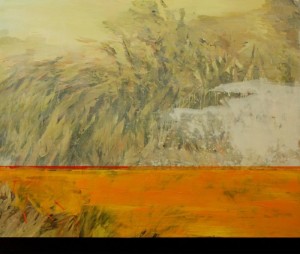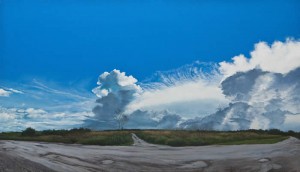The Star, 18 July 2010
Fleeting moments
by Amy de Kanter
Wong Perng Fey and Chen Wei Meng’s art captures the beauty of their surroundings, and the sorrow that moments of such beauty are soon gone forever.
ALTHOUGH I’m ashamed to admit it, going to see Heartland was the first time I have been to the lovely Wei-Ling Gallery in Kuala Lumpur.
The site used to be an old Brickfields shophouse that was gutted by a fire several years ago; the building that rose from those ashes was designed by gallery owner Lim Wei-Ling’s father. It makes intelligent use of space and natural light and is ideal to show the work of artists such as Wong Perng Fey and Chen Wei Meng.
This is the first time the artists are showing together, but when you see and understand their work, all you do is wonder what took them so long.
On the surface, their paintings are very different because their treatment of their subjects seems different. It isn’t really, although Wong’s may at first appear to be abstracts while Chen’s landscapes are so detailed, at a distance they could be mistaken for photographs.
In reality they are both painting the same thing with the same underlying feelings and a shared understanding of what a painting should be.
Both artists paint fleeting moments. In Wong’s case, the moment is fleeting because of movement. His landscapes are momentary glances out of the smudged window of a moving train. The top and the bottom of the painting are divided somewhat by colour, but also by a straight, horizontal line cutting across the canvas. “If I feel lost, I go on a journey,” Wong says.
Journey is a word both artists use often. When talking about how the idea for Heartland first came about, Chen says: “I called (Wong) and said I wanted to do a two-man show … I was already on this journey.”
In Chen’s case, the moments he captures are fleeting because of where we are in time as a country. He paints landscapes that are changing: a beautiful landscape with long grass and lush slopes, then in the background, a hill denuded of all foliage, ready to be levelled or built upon (Surreal Evening).
In another there is a bare tree, like the ones we expect to see in a winter landscape, not in our tropical one against a brilliant blue sky and light-edged clouds. We are standing in the middle of a dirt road as we watch, a road as grey and cratered as the surface of the moon, with potholes created by the trucks ferrying building materials back and forth.
This painting is called Nostalgic and the site has since been swallowed up by development, the tree gone, the ground tarred over and the sky obscured by buildings.
As for Wong’s work, it forces you to squint and try to make out the shapes streaked by speed and smudged glass.
Most striking among Wong’s work is A Windy Afternoon. Unlike the others that were divided in two, this canvas was covered in white paint, the horizontal brushstrokes visible in the direct sunlight. A band of colour cuts across the large canvas, a strip of beautiful pale greens and pinks.
While the artists suggested that everyone would see something different, I found my perception coloured, so to speak, by the proximity to Chen’s work. The greens in Wong’s paintings, well, that was obvious. It was the green of Malaysia’s natural landscape, the grasses and the trees. But what was the pink? Not a sunset, or flowers….
Then all became clear when I looked back at Chen’s Banana Palm, and saw, in trenches carved among the dark greens, Malaysia’s orange clay soil.
Both artists agree that it is impossible for any two people to even see, let alone create, identical art. Who we are and what we have experienced and even how we are feeling at the moment affects how we interpret and react to what we see. To them, the cord is cut between art and artist once the painting is completed, and once it is done, it cannot be changed. A successful painting carries the possibility for other people to come nearer to themselves, not to the artists.
As for the pervasive feeling this visitor got, it was best expressed by the title of Chen’s piece, Nostalgic. The beauty of memories tinged with both the gratitude for having seen what we did, and the sadness at knowing it will never be seen again.
‘Heartland’ is on show until July 31 at Wei-Ling Gallery (No. 8, Jalan Scott, Brickfields, KL). For details call 03-2260 1106 or e-mail weiling@weiling-gallery.com.



